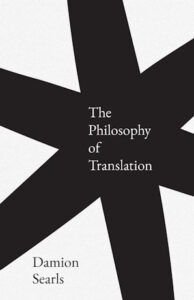In my late twenties, when I was interested in maybe becoming a translator but didn’t know how to go about doing such a thing, my mother suggested I try getting in touch with our old neighborhood friend Edie. I had read Dr. Seuss at her apartment on the Upper West Side of Manhattan, later babysat her son. She’s stopped teaching and become a translator, my mother said. What language? I asked. My mother didn’t know, maybe Spanish?
Article continues after advertisement
Wait a minute, Edie Grossman was Edith Grossman, legendary translator of García Márquez and soon to be of Cervantes?
I got back in touch, and Edie kindly agreed to let me send her my first translation effort, a short descriptive vignette by Peter Handke. She knew no German, had never read Handke, but took a look. Along with being encouraging about my translation and nicer than it deserved, she gave me some advice: Don’t use “-ing” words if you can help it, she said, they’re weak in English. Don’t say there’s a gleaming in the snow, say there’s a gleam; instead of a cocoon hanging in the trees, say it hung in the trees. She circled three of the “-ing” words in my translation and said that those were all right but I should recast the rest. When I looked back at the German, those three—only those three—had the “-d” verb suffix analogous to “-ing.” The verb I had translated “was hanging” could be “hung”; the noun could be a gleam, not a gleaming.
It is indisputable, I think, that translation is a certain kind of writing linked to or coordinated with a certain kind of reading.
In telling this story over the years, I’ve found that other translators tend to be less impressed by it than nontranslators. But at the time I was one of those nontranslators, and it gave me an eerie sense of being in the presence of greatness: Grossman knew what she was doing, Handke knew what he was doing, and they could commune with each other right through me. Aside from the practical lesson—not a single one of the, I don’t know, a million? verbs I have run across in the twenty-five years since then have I translated without thinking about this advice—the encounter taught me something else too: that translation didn’t work the way I thought.
Edie knew no German at all, and even if her advice was the product of her expertise in English, her matching the exact three and only three participles in German was a feat of reading, not just of good English-language writing. It was not a matter of linguistic competence, or not only, and while clearly it involved mastery in something to do with language, it was not any kind of mastery I understood. Whatever the process is that transforms an original into a translation, she was doing it, and if I ever wanted to do it too I was not going to learn how simply by improving my German.
*
It is indisputable, I think, that translation is a certain kind of writing linked to or coordinated with a certain kind of reading. This isn’t a definition of translation yet, because we haven’t said what kind of reading and writing they are and how they go together, but I think it’s undeniably true as far as it goes: translating is reading one text and writing another where there’s some specific relationship between the two.
In this combination, I would argue that writing as a translator is pretty much the same as any other kind of writing. A translator uses the resources of the language they’re writing in to produce a text that will be read and received within the context of that language. A translation into English is going to find its place in a literary universe—and a literary marketplace—of other English texts, so a translator of, say, Chinese poetry has to find a version of English poetry in which the poems will make sense to their readers. The translator can’t do what writers in Chinese do—can’t lean on the resources of the Chinese language, can’t try to do what the original text is doing in the original language—they have to make a text that does something worthwhile in English.
This is another way to say that a translator is not just a copyist, trying to replicate the original as closely as possible: a translator is necessarily producing new work in and for a new context—in this case an English-language context— different from the original’s. One key fact about that new context, for instance, is whether or not the author is already a known quantity there; if they are, you have to think about what you want your intervention to be: are you trying to just add more work to the author’s existing corpus in English, or to redefine the author, emphasizing aspects of their work you think have been underappreciated? Your goal will sometimes push you to translate more closely, if you feel something has been missing in English, and sometimes more freely, if you feel the ground has been covered well and you can take the basics for granted.
There are wider aspects of the context as well: whatever the status of the specific author, translators are often trying to change the new audience’s more fundamental expectations of what’s possible. (I sometimes want to show English-language readers that German writing can be funny; the translator Anton Hur wants to show English-language readers that there are contemporary queer voices in Korean; Daisy Rockwell, a translator from Hindi, wants to show that there are timeless, world-class, “canonical” novels in hitherto underrepresented languages…) These aspirations will affect what you decide to translate, how you make the books sound, and how you publicize and talk about them.
As writers go, a translator operates under an especially strong constraint: to produce a text that’s a translation of the original, not some random new thing. But every writer operates under constraints, of genre and tradition and readerly expectations and the language itself. Even if you’re writing your very own novel, you still have to do what a novel is supposed to do in English in 2024 in the United States or wherever you are, in the realist tradition or some anti-realist tradition, or else you have to recognizably push against those expectations. That is how you and everybody else will know that what you’re writing is a novel in English, as opposed to something else.
So that’s a difference in degree from the constraints on producing a translation, not a difference in kind. Translation is unlike other cases because it involves another language, but there are some kinds of analysis where this particular difference makes a difference and others where it doesn’t. For example, when you’re talking about a translation as being a take on, or version of, the original—like a performer’s specific way of interpreting a preexisting piece of music—then the fact that the translation is in a different language is more of a technicality.
But while writing as a translator is pretty much the same as writing like anyone else, reading as a translator is different from just reading. The defining feature of the act of translation is the kind of reading the translator is doing, and the philosophical account of translation in this book is of what it means to read like a translator. The Philosophy of Translation is not a craft book of tips on how to write translations, unless it counts as a tip to encourage translators to pay attention to as much of what you care about as you possibly can. In other words: read as deeply and completely as possible, and read like a translator in the ways I will describe, while practicing the same art and craft of writing as in nontranslated texts.
The defining feature of the act of translation is the kind of reading the translator is doing.
I will begin with, but quickly abandon, the nearly universal and often unexamined image of translation as bringing an original text from one language into another. This is an image of two isolated villages or islands, separated by some kind of gap, with no contact between them except that lone, special, unusually mobile person, the translator, who is able to bring messages from one place to the other, maybe even occasionally smuggle in some food. Although this is sometimes the right way to talk about translation, it usually isn’t. It creates all sorts of false dichotomies, mischaracterizes what translators actually do, misrepresents the continuities between translation and other kinds of writing, and misunderstands the nature of reading.
Reading—“this fruitful miracle of communication in the bosom of solitude,” as Proust called it in a translator’s preface— is miraculously and mysteriously neither objective nor subjective, neither purely taking something in nor purely revealing or expressing what’s inside oneself. It is a complex interplay of the self and the world, analogous to perception—we see what’s really there in the world, but we see it, and it’s there in our world, the environment we move in and care about, which is different from the environment of any other person or animal in the same physical space.
Likewise, we read the book itself, but we read it, from our particular perspective. And when we translate the book, we translate our reading of the original. A view of translation as first and foremost reading has surprisingly wide-ranging consequences, from what it means to translate “faithfully” to the abilities of ChatGPT.
One reason to call this process “reading”—as opposed to calling it “analyzing” or “understanding” the original—is the different amount or kind of authority it presupposes. As a translator I feel that I read deeply and well, but not that my reading outranks or preempts other readings, the way a correct interpretation or analysis implicitly criticizes incorrect ones. I can and do sometimes criticize other translations as wrong, or bad, but this process feels entirely separate and detached from the translation process: it feels as if once we have rejected a mistranslation, we are no step closer to arriving at our own preferred translation. I want to describe translation as something like moving through the world, not anything like choosing from a list of options.
__________________________________

From The Philosophy of Translation by Damion Searls. Published by Yale University Press. Copyright © 2024. Reproduced by permission.
